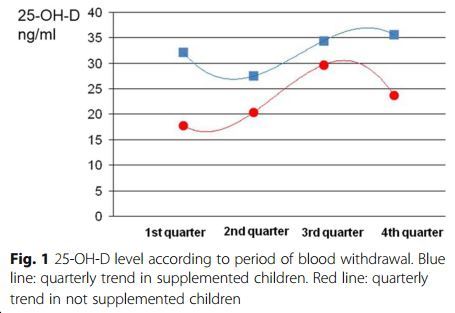Young white children helped by 1500 IU of vitamin D
Effect of vitamin D3 seasonal supplementation with 1500 IU/day in north Italian children (DINOS study).
Ital J Pediatr. 2019 Jan 28;45(1):18. doi: 10.1186/s13052-018-0590-x.
📄 Download the PDF from Vitamin D Life


Mazzoleni S1, Magni G2,3, Toderini D4.
1 Primary Care Paediatrician Azienda ULSS 6 Euganea Regione Veneto, Polistudio Pediatrico, via D'Annunzio 3/A, Piove di Sacco, Padova, Italy. [email protected].
2 Senior Biostatistician, NRC Azienda Ospedaliera Padova, Padova, Italy.
3 Unità di Ricerca Clinica, Istituto Oncologico Veneto, Padova, Italy.
4 Endocrinologist and General Practitioner Azienda ULSS 6 Euganea Regione Veneto, Studio via Benizzi 6, Padova, Italy.
BACKGROUND:
The appropriate dose of vitamin D supplementation in children is still debated. We calculated that the recommended dose of 600-1000 IU vitamin D3/day is not sufficient to reach a serum 25-hydroxyvitamin D (25-OH-D) level of at least 30 ng/ml (75 nmol/l) in north Italian children > 12 months. The aim of this study was to analyse the effect of seasonal supplementation with 1500 IU (=37.5 μg) vitamin D3/day.
METHODS:
DINOS (D-vitamIN Oral Supplementation) study was a pilot, monocentric, non-random case-control register study. It was conducted in a paediatric primary care setting near Padova (North Italy, 45°N latitude). The data of 203 children (girls:boys 1:1,33) aged 2-15 years, collected between November 2010 and January 2015, were analysed. Active group A (n = 82) were given 1500 IU vitamin D3/day from November to April ; control Group B (n = 121) received no supplementation. The serum 25-OH-D test was part of a laboratory tests panel and performed using a chemiluminescence immunoassay method.
RESULTS:
Serum 25-OH-D mean level + standard deviation throughout the period was 32 + 13 ng/ml (80 + 32 nmol/l) in group A vs 22 + 10 ng/ml (55 + 25 nmol/l) in group B. In group A 12% had vitamin D deficiency 25-OH-D < 20 ng/ml (50 nmol/l) and 1.2% severe vitamin D deficiency 25-OH-D < 10 ng/ml (25 nmol/l). In group B 46% had vitamin D deficiency and 9% severe deficiency (P < 0.001). In group A mean levels were normal or near-normal all the year except in May. Group B reached mean 25-OH-D levels close to 30 ng/ml (75 nmol/l) only in late summer. The active group mean 25-OH-D level was normal in preschoolers and schoolers but not in adolescents. Non-white children had a three-times vitamin D deficiency probability despite supplementation.
CONCLUSIONS:
Vitamin D supplementation with at least 1500 IU vitamin D3/day from November to April was found appropriate for children in North Italy. A prolongation until May could be useful. Higher doses and/or prolonged periods could be more appropriate especially in adolescents and in non-white children.
